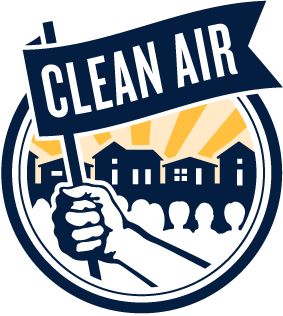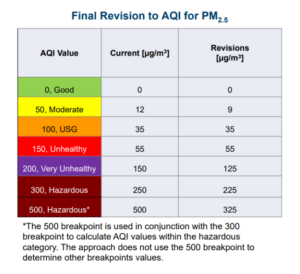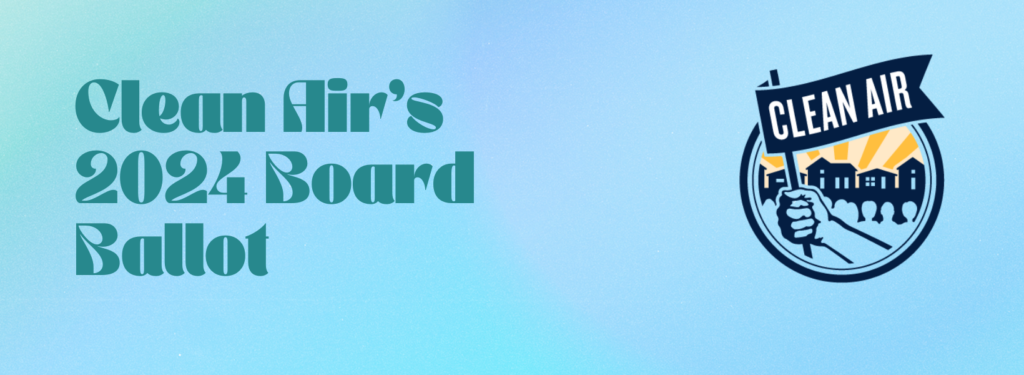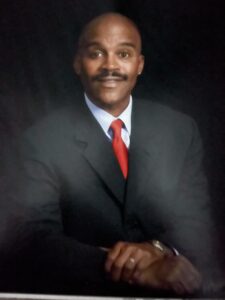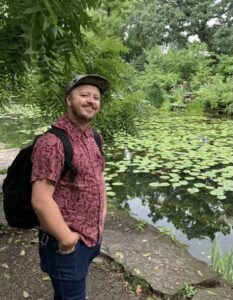April 9, 2024 – Clean Air Coalition Rallies with Drag Performer to Alert Public About Deficiencies in the Town of Tonawanda Draft Zoning Code
Last night, Clean Air rallied with drag performer Freddie Hercury to raise public awareness of deficiencies we have identified with the draft zoning amendment, as well as to drive attendance at the public hearing on the draft.
While the town board did vote to move forward with the draft as written, members of the Town’s staff, board, and the consultant team did concede that there needs to be immediate follow-up to address issues we and members of the public raised. In particular, definition of “Adult Cabaret Entertainment” that was carried over from the former draft was identified by town staff as “antiquated and illegal wording” in their response to the public comments.
All agreed that this is a living document that will be built on, so our work continues, in the Town and beyond. Town staff also noted that the Comprehensive Plan will be revised this year, so many of our larger policy asks could also be codified as part of that process. If you are interested in joining our advocacy work for equitable and just development in our membership area, particularly the Tonawandas, please reach out to Bridge about our Tonawanda Tomorrow Team.
The audio recording of last night’s hearing and meeting is available by clicking here, and video of our rally is below, as are photos from the entire evening. Further down is the text from our press release.
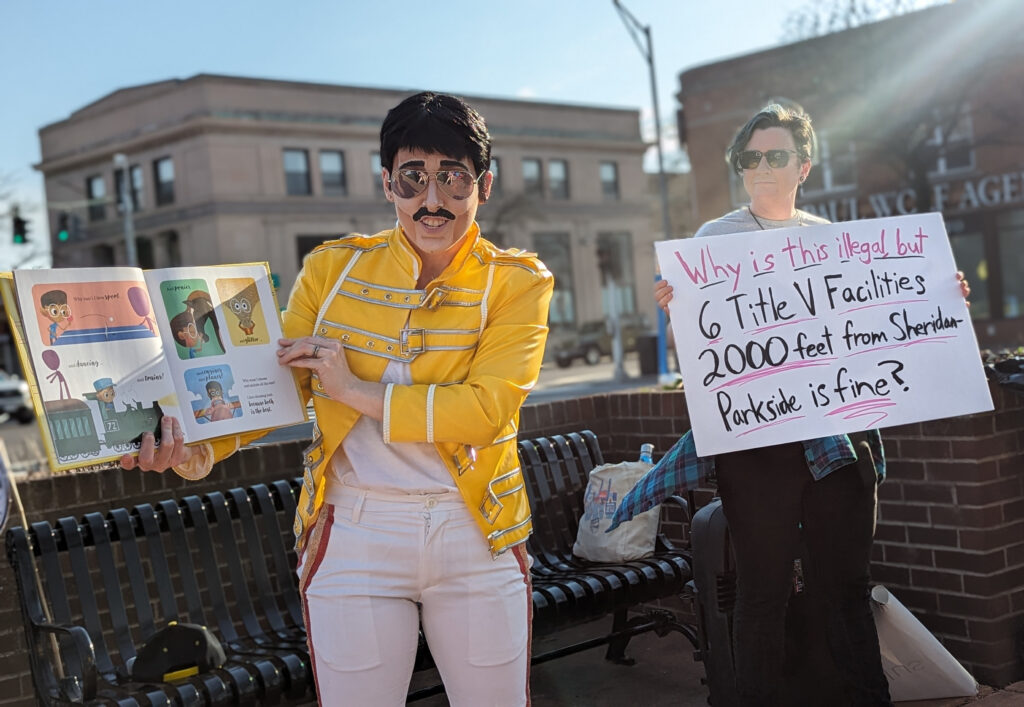 | |||
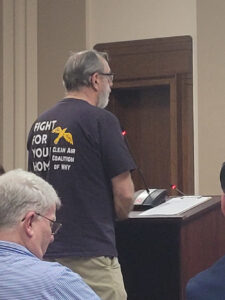 | 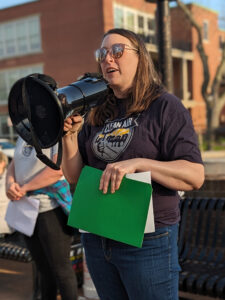 | 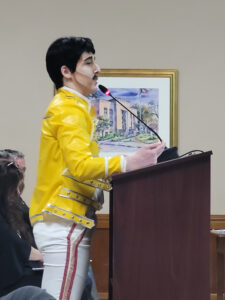 | 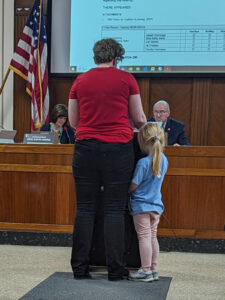 |
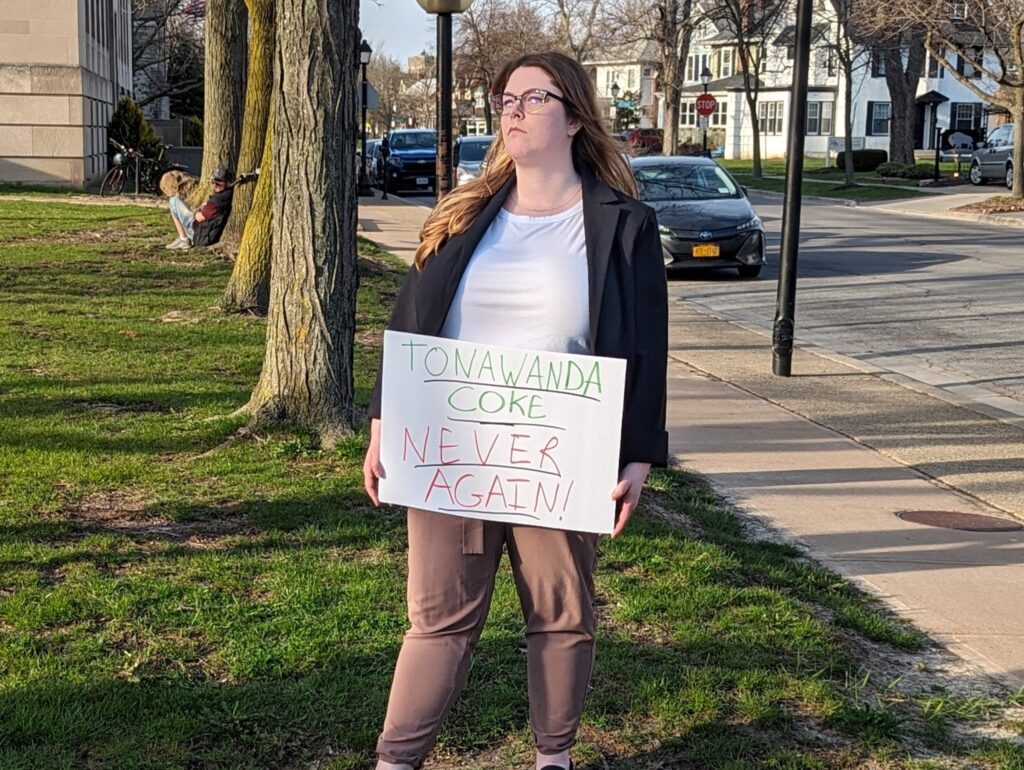 | |||
Press Release, April 9, 2024
Clean Air Coalition Rallies with Drag Performer to Alert Public About Deficiencies in the Town of Tonawanda Draft Zoning Code
Town to Hold Public Comment Hearing Tonight on Draft Code After Rally
Kenmore, NY: The Clean Air Coalition of WNY rallied today, April 9, 2024, prior to the Town of Tonawanda Town Board meeting to alert the general public of a public comment hearing the Town held on the draft Comprehensive Zoning Law Amendment, as well as to flag some deficiencies in the draft zoning code that they found.
Clean Air highlighted how this is a prime opportunity passing by to add protections in the zoning code for residents who live in areas currently zoned for industry, such as residents who live adjacent to the former Tonawanda Coke facility.
Adding these protections would also bring the code into alignment with recent state legislation, such as the Cumulative Impacts bill which was signed into law in December 2022 and which requires municipalities and regulatory agencies to consider whether a neighborhood is bearing a disproportionate pollution burden due to inequitable siting of industrial facilities, such as census tracts 83 and 84, which are home to six Title V facilities that lie within 2000 feet of residential areas, such as the Sheridan-Parkside neighborhood.
As Clean Air’s Board Chair and former Tonawanda Town Engineer James Jones (he/him) noted,
“Opportunities like this to rewrite and update our zoning codes extensively only come along once in a generation for the most part. We should take advantage as fully and completely as possible to instill best practices related to our environment, our mobility and our economic future together as a community. This draft falls short on many of the recommendations our organization has put forth with respect to these metrics.”
Clean Air also noted that some discriminatory language from the prior version of the zoning ordinance, originally written in the 1940s, has been carried forward into this version. Of note, the definition of “Adult Entertainment Cabaret” largely bans drag performances in all areas of the Town except those zoned Industrial. Clean Air invited local drag performer, Freddie Hercury (he/they), to join the rally and hold a drag story hour to protest the continued restrictions. Freddie Hercury said
“Drag is so much more than the sterile wording of long outdated laws would have people believe. Drag is hope, drag is joy, drag is art, and drag, quite literally, saves lives.”
Clean Air is also extremely concerned about the shortcomings in the town’s public outreach and engagement process to date. As Tonawanda resident Melissa Hubbard (she/her) noted,
“I’m here tonight because I care about Tonawanda, but I know that there are many residents who care just as deeply but could not be here. I call on our Town Board to create more opportunities for residents to talk with one another about zoning and how it impacts the Town. Everyone who lives in Tonawanda should have an opportunity to participate in this process. To me, that’s what democracy looks like.”
The Clean Air Coalition of WNY calls on the Town of Tonawanda Town Board to work in partnership to continue to amend the code with a focus on environmental justice and equity, and to take swift action through separate legislation to address the deficiencies identified.
For more information, please contact Clean Air’s Environmental Justice Organizer for our Tonawanda-area campaigns, Bridge Rauch, (they/them) at bridge@cacwny.org.
Rally on April 9 Prior to Town of Tonawanda Hearing on Zoning Amendment
CLEAN AIR TO HOST RALLY ON TUESDAY APRIL 9 AT 5:30PM AT 2919 DELAWARE AVENUE
On Tuesday April 9 at 7pm at the Municipal Building at 2919 Delaware Avenue the Town of Tonawanda will be holding a public comment hearing on the draft comprehensive zoning amendment. We expect a vote on approving the current draft will follow during the scheduled Town Board meeting.
Clean Air urges all members, supporters, Town residents, and residents of adjacent communities to join us at 5:30pm in the village green in front of the Municipal Building for a brief rally to bring attention to the hearing and to voice concerns that we have with the existing draft. The rally will begin promptly at 6pm, with a brief demonstration at 5:30, and Clean Air staff will be there at 5pm.
Directly after the rally we will go upstairs to the municipal meeting hall for the hearing and the meeting that will follow – we encourage our supporters to read through our following talking points and include these and any concerns you personally have in your remarks. You can also learn more by visiting the Town’s webpage on the comprehensive zoning amendment, or read the letters we and Smart Growth America submitted in August 2023.
We recommend that our supporters ask that the vote on the draft be tabled for a later meeting to allow for a second public comment hearing with broader outreach, or, if passed in this meeting, that the Town Board take swift action to amend the code and address the issues that we have flagged through separate legislation. Zoning codes are living documents that must be continually tweaked and updated for equity and justice, and the Town should continue to make ongoing reforms.
OUR REMAINING CONCERNS WITH THE PROPOSED DRAFT
- Clean Air remains concerned about the Town’s approach to public engagement and comment solicitation. The first several pages of our initial August 2023 letter flagged this issue, and we’re distressed to see that this hearing is being held without an improved outreach effort.
- The revised draft is dated February 1, 2024 but was not available to the public until February 11, and was only posted to the above-linked sub-webpage of the Planning and Development Department.
- We did not see anything posted to the legal notices page about an official public comment period until the hearing notice posted on March 26, and this notice did not include clear instructions on how to submit comments beyond the hearing.
- As of April 2, 2024, outside of a note on the calendar, there is nothing posted on the Town’s homepage announcing the public hearing.
- As of April 2, 2024, there has been no notice of the hearing posted to the Town’s social media accounts.
- Clean Air and Smart Growth America, subject-matter experts on zoning codes with a lens for progressive climate-friendly development strategies, submitted comments during the unofficial public comment period in summer 2023. We feel that these comments were not integrated in any meaningful way into the final draft.
Our lengthier analysis is below, including specific smaller tweaks that the Town could make to bring it closer to alignment with the points we raised in our letters, but
the number one point we would love our supporters to emphasize is that the Town should pass an Environmental Justice zoning ordinance for census tracts 83 and 84 (identified as areas disproportionately affected by environmental injustices by state and federal authorities), which would also align the code with the new statewide Cumulative Impacts law. - In our analysis, we further feel that the draft zoning amendment does not fully align with the goals set out in the Town’s 2014 Comprehensive Plan Update nor the goals of the Tonawanda Tomorrow plan that Clean Air worked extensively with the Town to develop. Here are two examples –
- “The Town shares boundaries with the Village of Kenmore, the Town of Amherst, the City of Buffalo, the City of Tonawanda, the City of North Tonawanda and Town of Grand Island (at Niagara River). In areas adjacent to the municipalities, especially the Village of Kenmore where the boundary appears “seamless”– village land use patterns should be continued. The zoning that extends along these municipal boundaries should be coordinated with the adjoining communities to correlate zoning classifications, bulk standards, design requirements and other regulations guiding development.” (Page 151, 2014 Town of Tonawanda Comprehensive Plan Update)
- At present, the Town’s former landfill at 15 Pirson Parkway remains zoned Mixed Use Industrial. This is despite a residential neighborhood in the City of Tonawanda which backs up to this site, and residents there have struggled with nuisance issues related to the regrading of this site. We urge the Town to rezone this parcel as Community Facility or Open Space to prevent industrial development in these resident’s backyards.
- “Reevaluate the Town’s zoning structure to consider greater opportunities for mixed uses and non-residential uses in residential districts. Consider a hybrid form-based code.” (Page 153, 2014 Comprehensive Plan Update)
“Promote housing models that are currently lacking in the Town, including mixed-use developments near walkable centers, single family homes with 4+ bedrooms, and live-work spaces.” (Page 47, Tonawanda Tomorrow Plan)- At present, the Town’s code maintains strict Euclidian separation of residential and non-residential uses, even including separation between single-family and multi-family homes which use the same design forms and are indistinguishable from the street and share the same community characteristics. While some separation of uses are of course necessary, we urge the Town to revisit unnecessary separations that remain in the code to increase accessibility, inclusiveness, and walkability, and, longer term, adopt a form-based code to match with modern best planning practices.
- “The Town shares boundaries with the Village of Kenmore, the Town of Amherst, the City of Buffalo, the City of Tonawanda, the City of North Tonawanda and Town of Grand Island (at Niagara River). In areas adjacent to the municipalities, especially the Village of Kenmore where the boundary appears “seamless”– village land use patterns should be continued. The zoning that extends along these municipal boundaries should be coordinated with the adjoining communities to correlate zoning classifications, bulk standards, design requirements and other regulations guiding development.” (Page 151, 2014 Town of Tonawanda Comprehensive Plan Update)
- Additionally, in the months since we submitted our initial letter, we have noted that while Tonawanda officials and residents have expressed their strong opposition to the mining of cryptocurrency as an industrial or commercial use, there are currently no laws, regulations or ordinances banning this practice.
- From conversations we have had, we have gleaned that officials are also largely unaware that the phrase “Data Center” is usually used by developers to hide plans for cryptocurrency mining operations. Common issues with cryptocurrency mining include large energy uses which risk grid brownouts, and the requirement of large industrial fans to cool computer servers, which can be as loud as jet engines when at peak operations.
- Town officials should strongly consider either incorporating a ban on cryptocurrency mining into the zoning amendment or plan to address this regulatory gap in the near future, as plans for several former industrial sites located in the River Road corridor that are presently in the Brownfield Cleanup Program include Data Centers, and these developers have a proven record of partnering with cryptocurrency mining firms.
- Alternatively, in lieu of a total ban, the Town could consider adopting a zoning ordinance similar to Niagara Falls’ High Energy Usage Overlay District, which cuts to the core of the nuisance issues at hand – loud, persistent noise, and large energy uses, either with grid power which can increase instability, or with off grid power, which, depending on the power source, can substantially reduce air quality and increase greenhouse gas emissions.
- These nuisance issues are not unique to cryptocurrency mining, which is why Niagara Falls’ tact may be more sensible than a ban specifically on cryptocurrency mining. For example, data centers used for ChatGPT and other Artificial Intelligence generative modeling also consume large amounts of energy and likewise require large fans, as do emerging Direct Air Capture operations, and new industrial cannabis growing operations require large amounts of energy for grow lights. Our advocacy for an Environmental Justice overlay could also dovetail into this ordnance, as brownouts and noise complaints from industrial sources are common among residents of EJ areas.
This has been a long process, and we understand that the Town would like to move forward to support development.
We also understand that these issues are not unique to the Town of Tonawanda – municipalities tend to share the same zoning language and are generally slow to make updates as issues arise. For example, the City of Tonawanda requires even larger minimum residential lot frontages (60 feet versus 45 feet), and most area municipalities, including the Village of Kenmore, also have the same outdated Adult Entertainment Cabaret definition which restricts drag performances to Industrial zones.
Even the City of Buffalo, which received international recognition for the relatively progressive “Green Code” zoning updates made in 2016, continues to lack Inclusionary Zoning housing affordability protections, and our campaigns in Buffalo are directly related to poor parcel zoning decisions as well as a lack of enforcement of the existing laws on industrial business operations.
Clean Air will continue to exert pressure on these policy areas, in particular supporting the codification of Environmental Justice into zoning codes throughout our membership areas and the broader region. If you are interested in joining this work, please reach out to Bridge.
ANALYSIS OF THE REVISIONS TO THE ZONING AMENDMENT MADE IN RESPONSE TO CLEAN AIR AND SMART GROWTH AMERCIA’S COMMENTS
Clean Air’s comments, submitted August 31, 2023
Public engagement process – no meaningful improvement.
- Revised drafts are dated 2/1/24
- Updated draft was posted to Zoning Amendment webpage week of 2/11/24.
- Nothing posted on legal notices about the new draft as of 3/25/24
- Nothing posted on home page about the new draft as of 3/25/24
- Nothing posted to town’s Facebook page as of 3/25/24
“We further encourage adding a 10-30% affordable housing requirement to the Planned Unit Development Districts and the Transit-Oriented Development Districts for residential developments of 5 or more units, with the median income for determining affordability pegged to current census tracts, not the Area Median Income of the region.”
- Remains unchanged. No set percentage requirements for affordable housing development within these or any zones.
- TOD definition does not include affordable housing as a goal, but does include the goal of “moderate-income housing” (§215-23.6 – F.) “Moderate-income” is not defined nor is this phrase used anywhere else we could find either in . The Town should, at a minimum, swap out “moderate-income” for “affordable” to align with not only our suggested requirements but also the standard language used elsewhere in code.
- PUD definition does not include affordable housing as a goal, but does include the goal of “Facilitate the provision of housing and improved residential environments” (§215-23.7 A4) and has a section on Public Benefit (§215-23.7 F) which does not include affordable housing, or any mention of housing whatsoever. The Town should, at a minimum, add “affordable” to the housing goal A4 and include affordable housing within the potential Public Benefit justifications.
- We also strongly recommend including a definition of “affordable housing” within section §215-15.7, and additionally suggest using the Average Median Income for the Town’s census districts rather than the AMI for the region as threshold measures.
“We object to the continued use of restrictive Euclidean-style Single Family zoning (R-1) for the vast majority of the residential areas of the Town.”
“We are further troubled to see that the R-1 zoning has a minimum lot width of 45’, minimum front setback of 25’, and minimum lot area of 4,500 square feet.”
“We are also troubled to see that R-1 requires two spaces for cars , and does not permit Accessory Dwelling Units/In-Law Suites even with a special use permit…. We also noted that Building-Mounted Wind Energy Conversion Systems are not permitted anywhere except Industrial and Mixed Use Waterfront areas.”
“We instead suggest a minimum lot width of 25’ for new build structures, a setback defined by the front yard line of the block, and a minimum structure size set by percentage of lot covered rather than a specific required size. In the City of Buffalo, minimum lot widths for residential zones can be as narrow as 15’, but the N-2R residential areas that are most closely similar to Tonawandas R-1 district have minimums of 25’. The N-2R setback minimum in the city of Buffalo is not defined strictly, but rather is +/- 5’ from the established front yard line on the block. Finally, while the minimum lot size is 1500 sqft, rather than any specific minimum defined building requirement, instead structures must cover LESS than 70% of the lot.”
- Part 2 District & Use Regulations §215-20.5 Table 20-b remains unchanged, with 45’ minimum lot sizes for R-1, R-2 & MR zones and 25’ setbacks for R-1 & R-2 zones (20’ for MR zones.)
- Part 3 Development Standards §215-30.4 Table B remains unchanged, with requirements of 2 spaces per unit of single family housing, and 1.5 spaces per unit of multi-family housing.
- There is no mention of Alternative Parking Arrangements §215-30.8 in section §215-30.3 Residential Parking Requirements. Alternative Parking Arrangements for other zoning uses are at the discretion of the reviewing body and may require a Parking Demand Analysis, which disincentivizes Alternative Parking Arrangements.
“We suggest eliminating the requirement for minimum parking for new developments in residential areas entirely, and replacing instead with a Transportation Demand Management plan for larger residential developments.”
- Section 3 Off-street Parking Requirements §215-30.4 Table B Parking Minimums remains unchanged, with 2 spaces per residential unit or 1.5 per multifamily unit. There is a standard process for developments with fewer parking spaces that applicants can follow, but this creates an additional barrier that many developers will not bother with.
“We suggest allowing Accessory Dwelling Units and In-law Suites by right in residential areas, including in R-1 areas, and allowing installation of Building-Mounted Wind Energy Conversion Systems with a Special Use Permit.”
- Section 2 Residential Districts Use Lists §215-20.4 – Accessory Dwelling Units still require a Special Permit process in R-2 & MR zones and are not by-right uses, but are now permitted in R-1 zones with a Special Permit – positive adjustment possibly based in part on our feedback.
- Section 2 Residential Districts Use Lists §215-20.4 – no mention of Building-Mounted Wind Energy Conversion Systems as a permitted use, even with a Special Use Permit. Unchanged.
- As written, permitted only in §215-21.4 MU-W and §215-22.4 MU-I GI zones.
“We strongly support the development and addition of an Environmental Justice Overlay Zone for residential parcels within the General Industrial Zone and adjacent areas, particularly those areas defined by the State of New York under the Disadvantaged Communities Criteria… A placeholder in the draft codifying a commitment to develop this Overlay within the next five years would suffice for our concerns at this time, and we would happily work with the Town to facilitate neighborhood meetings and help develop this overlay.”
- Unchanged. No placeholder added.
“We strongly support striking the terms “male and female impersonators” from [the definition of Adult Entertainment Cabaret under Adult Uses]”
- Unchanged. Definition remains as previously written –
- “ADULT ENTERTAINMENT CABARET — A public or private establishment which is licensed to serve food and/or alcoholic beverages, which features topless dancers, strippers, male or female impersonators or similar entertainers.”
- Adult uses also remain restricted to MU-I and GI zones.
“We suggest in the future considering adding protective zoning measures against “box store” type suburban development”
- Not analyzed. This was more aspirational and a goal for future analysis/advocacy. The Institute for Local Self Reliance has a number of examples of how to add protective measures, like including a maximum square footage for retail businesses.
“We encourage publishing a simple 1-2 page guide breaking down the Draft Zoning Amendments prior to scheduling the Public Hearing.”
- Unchanged. There is a summary paragraph on the Zoning webpage, but no simple 1-2 page guide.
Smart Growth America’s Comments, Submitted August 31, 2023
“Review the Subdivision Regulations with a climate and environmental justice lens for consistency with the Comprehensive Plan and Zoning Ordinance”
- To the best of our knowledge, this has not occurred.
“The Town should convene a climate change-oriented steering committee for the draft zoning ordinance to oversee the inclusion of climate resilient land use policies. This steering committee should review the draft zoning ordinance’s climate-relevant policies and provide recommendations for specific language that should be incorporated into the zoning code update. The steering committee should pull from the Town’s planning department staff, but should have a clear term limit (when the updated zoning ordinance is adopted).”
- To the best of our knowledge, this has not occurred.
“Tonawanda might also consider specifically promoting knowledge of flood resilience as a desired qualification for a seat on the Planning Board.”
- To the best of our knowledge, there is no one with specific flood resilience and stormwater management knowledge on the planning board.
“All residential zoning designations in the draft zoning ordinance should explicitly allow a variety of housing types, with up to 10 dwelling units per acre (or even higher maximums). This density could be tiered, with lower DUA along the coastal areas and increasing density as development moves away from the waterfront and towards the more established community core.”
- Unchanged, feedback not incorporated
“Denser infill development has the potential to advance Tonawanda residents’ quality of life by supporting retail and mixed uses, introducing a wider variety of housing typologies for households of different incomes, and increasing accessibility to transit and other amenities. It can also reduce greenhouse gas emissions, vehicle miles traveled, sprawling surfaces and materials that retain heat and create pollution, and exposure to inland flooding. Reducing density controls such as setbacks, rear yard requirements, and floor area ratios in residential zones—while also including landscaping requirements as conditions of use and allowing by-right permits for the redevelopment and reuse of existing building stock—will provide stronger regulatory support for the Comprehensive Plan’s goals and aspirations to make the Town more climate resilient.”
- Unchanged, feedback not incorporated
“In order to advance the Town’s goals for development that is adapted to extreme heat and flooding, the draft zoning ordinance should include language to allow the creation and/or preservation of green space geographically distributed throughout the town. Many of the Town’s identified open spaces and community facilities are located along the riverfront and/or the edge of town. Locating natural spaces throughout the community, especially in residential zoned areas, will decrease the Town’s ambient temperatures and help manage stormwater and water quality. Incorporating green spaces on the riverfront can be a best practice for flood preparedness, and it is also critical to strive for distributed park access within close proximity to all residents.”
- While there weren’t any changes, Section 3 §215-31.13 specifically addresses the need for protected and expanded green space throughout the town
“Incorporating the following zoning and land use regulation updates could also help the Town deal with higher temperatures and a more severe heat island effect:”
- Residential zoning designations should include language to require the installation of shade amenities, including a street tree canopy, porches, awnings, porticos, etc. These amenities should be allowed with little regulatory burden; either by-right or via an “over the counter” permit. Additionally, approaches such as a Green Area Ratio can provide discretion to property owners about what combination of green and stormwater interventions they choose to incorporate on site.”
- Unchanged, feedback not incorporated. Only mention of shade is in Section 3 Article 31, which features mention of shade trees, largely in parking areas.
- “Landlords should be incentivized to install green or cool roofs via the inclusion of these amenities in the zoning text as a by-right use in all residential zones along with opportunities to support reflective surfaces. Currently, the omission of these elements serves as an additional administrative burden for those who might be interested in including these amenities. Incorporation of green design elements could be paired with an incentive such as a density bonus.”
- Green roofs and cool roofs are mentioned in Section 3 §215-32.6. Mild incentive to incorporate green roofs into new construction by allowing for greater build-to-lot ratio.
- “Where green roofs are proposed, the reviewing body may deduct a portion of the green roof building from the lot coverage calculations up to 75% of the green roof footprint.”
- Green roofs and cool roofs are mentioned in Section 3 §215-32.6. Mild incentive to incorporate green roofs into new construction by allowing for greater build-to-lot ratio.
- “Native vegetation should be incorporated into public facilities and street/sidewalk infrastructure; this should be allowed or required by-right in all residential zones.”
- Section 3 §215-31.4 B2 – “Native species shall be utilized to the greatest extent possible.”
“Recommendations aimed at helping the Town deal with increased precipitation and more severe flooding events include:”
- “Locate new public facilities inland to reduce their susceptibility to flooding.”
- Unchanged, feedback not incorporated – see Section 2 §215-23.5 FLOOD HAZARD OVERLAY (FHO) DISTRICT. The language of this section does not directly mention barring or restricting new construction of public facilities in this overlay area. This section largely directs readers to Chapter 92 of the Town Code (https://ecode360.com/10932590#10932590) and the FEMA Flood Zone Map for the area, which designates the boundaries of the Overlay.
- The Town does feature a flood plain map on their website in their GIS tools, although these are difficult to find and use for the average resident. You must first navigate to the Planning & Development Department webpage and then scroll down to the link to “Interactive Maps”. You must then know to select “Tonawanda Map Gallery” and then select “2021 Adopted Floodplain Viewer”, and then be experienced enough with GIS maps to know to zoom in to activate layers. This map does reveal that developed areas near Brighton Park are at high risk of flooding from Ellicott Creek, and discussions of managed retreat may be worth consideration to alleviate future disasters.
- “Issue permits for the installation of greywater systems for water reuse by-right or over the counter.”
- Unchanged, feedback not incorporated. Greywater is not mentioned anywhere in documents.
- “Use permeable materials for streets, parking lots, and sidewalks in flood-prone areas to reduce runoff, promote groundwater recharge, and mitigate the impacts of droughts.”
- Unchanged, feedback not incorporated. Section 3 §215-32.11 STORMWATER MANAGEMENT & GREEN INFRASTRUCTURE encourages but does not require green stormwater infrastructure. Upwards of 85% of a lot can be of impervious surfaces depending on the zoning type.
- “Reference the ASCE 24 guidelines on Flood Resistant Design and Construction for areas prone to flooding.”
- Unchanged, feedback not incorporated
- “Incentivize new development, and higher density development, in areas which are less flood-prone through by-right zoning or by introducing incentives such as density bonuses.”
- Unchanged, feedback not incorporated
Town of Tonawanda Zoning Hearing April 9
Last night the Town of Tonawanda Town Board voted to move ahead with a public comment hearing for the town’s comprehensive zoning amendment on Tuesday April 9 at 7pm at the Municipal Building at 2919 Delaware Avenue in Kenmore. Very likely, the vote to approve, table or deny the approval of the draft will follow directly after the hearing.
Please note that while the Town Board normally meets on Mondays, this hearing and meeting is on a Tuesday due to the eclipse on the 8th.
Clean Air encourages all residents of the Town as well as neighboring municipalities to attend and speak out, either about the draft under consideration for approval, or for land use issues that you would like the Town Board to consider in the future.
Click here for a Facebook event to share on social media and invite friends and family. Clean Air will be meeting prior to the hearing at 5:30pm on the 9th in front of the Municipal Building, with a rally at 6pm.
To review our comments and comments from Smart Growth America on the originally released preliminary draft, please click here. We will be posting an updated analysis on the draft under consideration on the 9th on this blog prior to the hearing.
To review the draft for consideration, please visit the Town’s website by clicking here, or click the links below. Remember to use “ctrl+f” to quickly find information on topics that are of interest to you.
- All parts combined
- New zoning map
- Part 1 – Introduction
- Part 2 – District and Use Regulations
- Part 3 – Development Standards
- Part 4 – Application and Review Procedures
- Environmental Assessment
March/April 2024 Monthly Updates – Happy Cesar Chavez Day!
Click here to subscribe to our monthly e-newsletter, and view this month’s edition by clicking the “Read More” link below.
EPA Particulate Matter Rule Changes
Guest post by Clean Air’s spring intern Clover Kagle
On February 7th,the EPA released an update to guidelines regarding the annual emission limits of PM2.5 particles. The new annual limit of 9.0 µg/m3 is a decrease of 25% from the previous limit, 12.0 µg/m3. The EPA bases the decision on the health requirements in the Clean Air Act and the National Ambient Air Quality Standards (NAAQS). The EPA claims the new guidelines will save over 4,500 lives over the next 8 years.
However, many agencies believe the stricter regulations do not go nearly far enough. The WHO has a recommended guideline of 5.0µg/m3, and many other countries already are enforcing this guideline. The EPA is not changing any secondary thresholds, PM10 thresholds, or 24-hour PM2.5 thresholds. The new limits do not affect most of the United States, with only 59 counties across the country needing to decrease their PM2.5 emissions to meet new guidelines.
Another change in this decision is the air quality index levels. The EPA released the following graphic showing the revisions to health safety levels denoted by AQI – note that the threshold for “Moderate”, “Very Unhealthy”, and “Hazardous” are now lower than the prior thresholds.
NYS DEC Public Meeting About Superfund Clean-up at Former Tonawanda Coke Site
The New York State Department of Environmental Conservation will be hosting a public meeting about a Proposed Amended Remedy for a portion of the former Tonawanda Coke site on Thursday, March 21, 2024 at 6 pm at the Kenmore Branch Library (160 Delaware Road, Kenmore, NY) as well as online. Click here to read the announcement and for online registration information.
When Tonawanda Coke closed and clean up began, the facility was portioned into several parcels, with Honeywell (the Potentially Responsible Party) charged with managing and paying for the clean ups at the Superfund-designated parcels, shown below with the black outlines, and the developers of the Riverview Tech Campus in charge of the brownfield portion of the site with taxpayer subsidies, shown below in the blue outline. This meeting is about Site 109, circled in red below. Click on the image to enlarge.
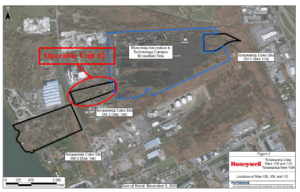
An “Amended Remedy” refers to a change in the strategy planned for cleaning up, or “remediating”, a contaminated site.
The changes proposed to the clean up plan for this portion of the site are –
- Excavating contaminated soil which exceeds protection of ecological resources soil cleanup objectives in the area of an on-site drainage ditch. Excavated soil will either be managed on-site or offsite based on the level of contamination in the soil;
- Collecting and analyzing post-remedial soil samples and post-remedial groundwater samples to evaluate the effectiveness of the remedy;
- Importing clean material that meets the established soil cleanup objectives for use as backfill;
- Construction of a cover system over the entire site;
- Implementing a Site Management Plan (SMP) for long term maintenance of the remedial systems; and
- Recording of an Environmental Easement to ensure proper use of the site may be necessary.
In simple terms, the amended plan proposes to dig up contaminated soils, move some to a controlled area of the site or off site to a hazardous waste landfill, studying the soil and groundwater left behind, trucking in clean soil to cover up the dug up areas, adding a cap on top (typically a plastic membrane), setting up monitoring stations, and then limiting public access to the site, including preventing any future development.
For a deeper dive, including the original planned remedy, see this document. More info is also available in the DEC’s document vault for the site, which you can find directly by clicking here or through the InfoLocator map.
Can’t make the meeting, but want to submit a comment or have a question?
For Project-Related Questions, please reach out to Benjamin McPherson, Project Manager, at NYSDEC, 700 Delaware Avenue, Buffalo, NY 14209 or 716-851-7220 or benjamin.mcpherson@dec.ny.gov.
For Project-Related Health Questions, please reach out to Angela Martin, NYSDOH, Empire State Plaza, Corning Tower, Room 1787, Albany NY 12237, or 518-473-4671, or beei@health.ny.gov.
To submit a public comment, please send to Benjamin McPherson at the above information. All public comments on this Amended Remedy must be submitted by March 29, 2024.
Want to get involved with Clean Air’s team advocating for strong clean up standards at Tonawanda Coke as well as other sites in the River Road industrial corridor? Join our River Road Watchdogs!
February/March Monthly Updates – Our Annual Meeting is Tomorrow, Tuesday February 27!
Click here to subscribe to our monthly e-newsletter, and view this month’s edition by clicking the “Read More” link below.
NYS DEC Commissioner Basil Seggos Stepping Down
Earlier this week NYS Department of Environmental Conservation Commissioner, Basil Seggos, announced he would be stepping down. Seggos has served in this role since 2015.
Seggos’ legacy is a mixed one, as journalist Peter Mantius notes. At our office we have a cardboard cut out of Seggos that we used in a public meeting in early 2020 to call out the parceling up of the Tonawanda Coke site to shift much into the Brownfield program, despite Honeywell Corporation’s clear role as a Potentially Responsible Party for the whole site.
While the final decision on this and other issues rests on the commissioner’s shoulders, ultimately this and other failings of DEC are due to systemic legislative policy decisions that prioritize corporate profits over public health and environmental justice, not just the decisions of one person – we need legislative reforms to shift these systems, such as changes to the Brownfield Clean-up Program.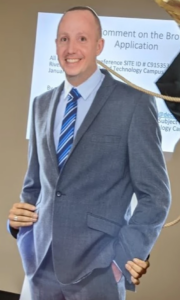
The Brownfield Clean-up Program Needs Reforms
Members of the Buffalo Building and Construction Trades Council rallied last week at the Wood & Brooks construction site on Kenmore Ave in Tonawanda to bring attention to a loophole in statewide prevailing wage laws. The law currently includes exemptions for projects that receive historic tax credits or brownfield tax credits.
In related news, the New York State Department of Taxation and Finance also recently shared the findings of a report on return on investment for these and other tax credit programs, and found that the Brownfield Program is currently returning only 11 cents per dollar spent, although the report also notes that researchers did not study other positive impacts like community environmental and public health or even the economics of reactivating these vacant parcels. We would love to see a more targeted study that examines these topics in particular, but we wager that taxpayers are not getting the full benefits from this program that we could be receiving.
Overall, the NYS brownfield tax credit program is in need of reform, not only to address the prevailing wages loophole, but also to strengthen community oversight of these remediations through Community Advisory Group and to direct the funds better towards downtown redevelopments that do not have clear parties responsible for the pollution. Far too often, we have seen large large industrial parcels which are still connected with polluters responsible for the contamination (Potentially Responsible Parties, or PRPs) placed in the brownfield program with taxpayer dollars subsidizing the clean up rather than these large corporations.
In early 2022 we co-sponsored a letter to legislators asking them to include these reforms to the Brownfield Clean-up Program which was signed by labor and community groups from all across the state. Unfortunately these reforms did not make it into the final version of the law, but it has spurred conversations in Albany and these changes can be added through legislation.
We applaud our friends in labor for continuing to raise awareness of these issues, and will share more on this issue in the future, including how you can support calls for change. If you would like to join the fight for these changes, please reach out to Chris.
Meet our 2024 Board Candidates!
We are excited to provide our members the opportunity to make their voices heard by voting on the 2024 Slate of Candidates for the Board of Directors. Answers from the Board Candidate Application are listed below so you can get to know our candidates. Cast your vote by our Annual Meeting on February 27. In order for your vote to count you must be a current dues paying member. This means you have made a financial contribution to Clean Air in the last calendar year and reside within our membership areas. Members can vote in 3 different ways; in person at the Annual Meeting, by mailing in your paper board ballot you will receive in the mail if you are a current member, or online by clicking the link here. You can register to attend the Annual Meeting here. Food, non alcoholic drinks, and childcare will be provided.
Board Candidate Name: Bryan Shepard
Why would you like to serve as a member of Clean Air’s Board of Directors? To increase community activism regarding environmental justice issues.
What skills, knowledge (learned or lived!) or experiences can you offer to the organization as a member of our Board? As a labor activist, environmental & safety issues directly affect our labor union constituency. I’ve learned that environmental justice will only come about if we demand it.
It is crucial that the Clean Air Board reflect the diversity of the communities that we are rooted in. The Board should be inclusive in terms of age, race/ethnicity, sex, faith/religion, ability, gender identity/expression, sexual orientation, social economic status, and more- just as our membership is. Please tell us about how you would support Clean Air in reflecting and embracing the diversity of the community. Enlighten community members to the fact that environmental justice affects everyone. We should look to increase membership in all communities across WNY.
Board Candidate Name: Xavier Eddy
Why would you like to serve as a member of Clean Air’s Board of Directors? I believe building grassroots power is the only way justice can be won! I’m extremely proud and impressed with the work Clean Air does, and I believe I can bring some fresh perspective and strategy to our organization.
What skills, knowledge (learned or lived!) or experiences can you offer to the organization as a member of our Board? Hopefully a lot! As a “professional” organizer, I’ve organized in geographically and culturally diverse regions across the country. I’ve been involved in Labor, Racial Justice, anti-imperialist, and Environmental Justice fights across half this country. I was heavily involved with a few Environmental Justice Organizations across the south and particularly in Cancer Alley in Louisiana. I also have an academic background in strategic corporate research and it’s role in successful campaigns, as well as experience review building permits, environmental permits, etc in construction. I also have experience as a street medic, and in organizing rallies and marches.
What do you hope to learn or try on as a Clean Air Board Member? I hope to deepen my connections with the various communities of WNY, and better my skills on the fundraising side of things.
One of the ways that we ask board members to do “the work” with Clean Air is to assist us in fundraising efforts. Are you open to inviting others to join our work by becoming a member or supporter? Are you open to learning more about fundraising and trying it on? Absolutely! I already am a member and would love to see us expand our membership to be even more dues based but am willing to assist in any form of fundraising.
It is crucial that the Clean Air Board reflect the diversity of the communities that we are rooted in. The Board should be inclusive in terms of age, race/ethnicity, sex, faith/religion, ability, gender identity/expression, sexual orientation, social economic status, and more- just as our membership is. Please tell us about how you would support Clean Air in reflecting and embracing the diversity of the community. My mentor in organizing was an old Chicano UFW organizer, and the number one thing he hammered into me was LUPE, la Union del Pueblo Entero. We must strive to build a union of the entire community. To build a truly grassroots organization, we must be both reflective of and responsive to the communities we work in and with. I’m young and queer, and grew up in Rural Poverty, and want to continue to grow a board and organization of kinfolk across all spectrums of diversity.
